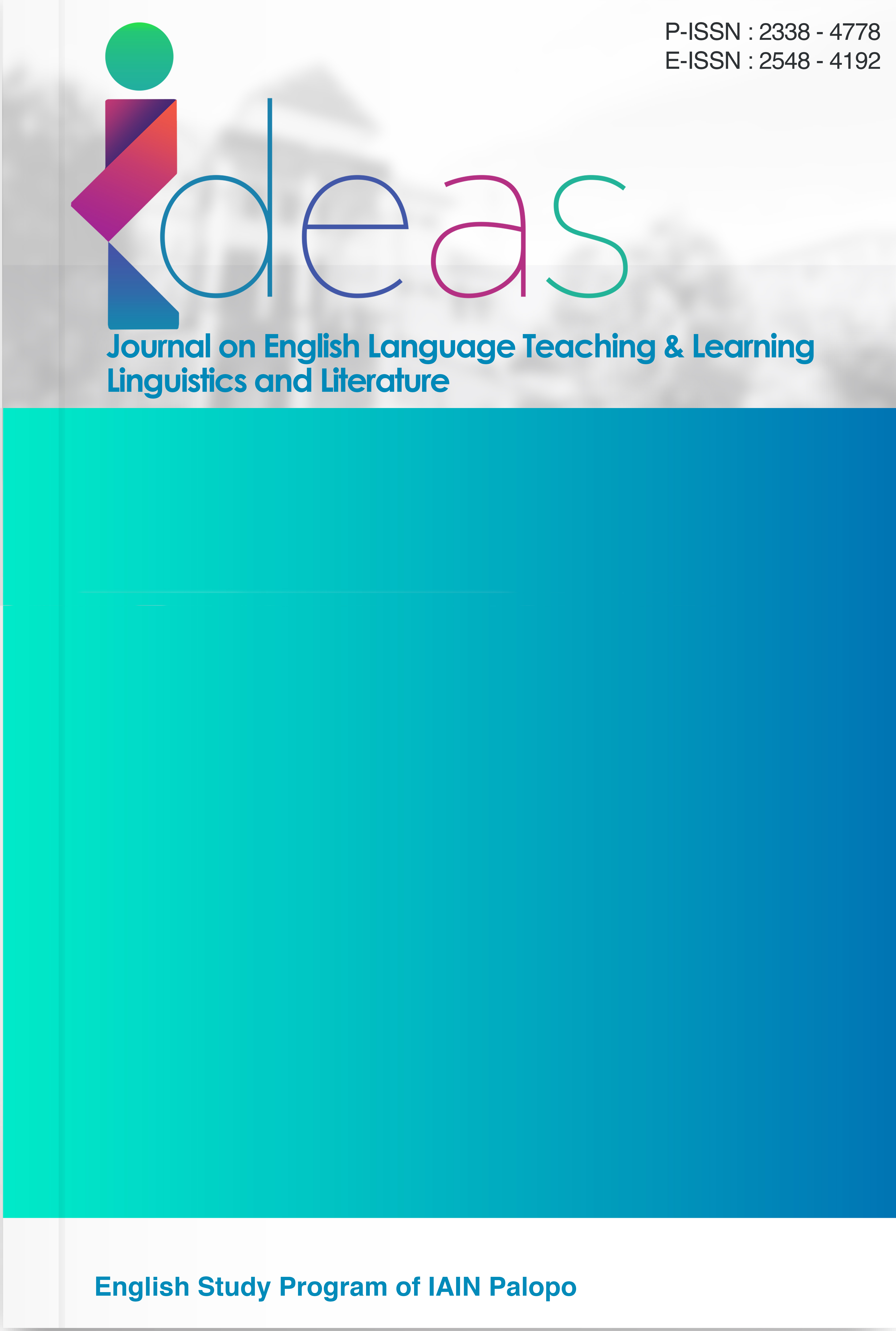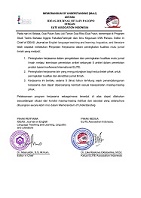Anthropocentric Symbols in Where the Wild Things Are by Maurice Sendak
DOI:
https://doi.org/10.24256/ideas.v13i2.7480Keywords:
Anthropocentric; Semiotics; Where the Wild Things AreAbstract
The purpose of this study is to analyze the anthropocentric symbols present in the children's storybook "Where the Wild Things Are" by Maurice Sendak. To explain these symbols, the semiotic theory proposed by Roland Barthes is employed in this study, which explains them through three levels: denotative, connotative, and mythical meanings. This study uses a qualitative research method and a descriptive approach that focuses on the images and words contained in the children's storybook entitled Where the Wild Things Are by Maurice Sendak. The results of this study indicate that the anthropocentric symbols contained in the children's story entitled Where the Wild Things Are by Maurice Sendak have appeared since the beginning of the story, namely since the transformation of Max's bedroom into a forest to Max's exploration of the forest that grew in his room until he was crowned "King of all wild things". These symbols have strengthened the ideological myth that humans are superior and destined to dominate nature.
References
Affifi, R. (2017). More-than-humanizing the Anthropocene. The Trumpeter, 32(2), 155–175. https://doi.org/10.7202/1042991ar
Ajmal, N., Khan, S., & Raza, A. (2024). Anthropocentrism in Children’s Literature: Michael Bond’s The Tales of Olga da Polga. Bulletin of Business and Economics, 13(2), 893–897. https://doi.org/10.61506/01.00405
Akinsulure-Smith, A. M., Ghiglione, J. B., & Wollmershauser, C. (2009). Healing in the midst of Chaos: Nah we Yone’s African women’s wellness group. Women and Therapy, 32(1), 105–120. https://doi.org/10.1080/02703140802384602
Aldiansyah, R., Ariyansyah, I., Efriani, E., Dewantara, J. A., Sulistyarini, S., & Sudagung, A. D. (2023). Studies on Environmental Ethics for Students in Indonesia. Jurnal Pendidikan Sosiologi Dan Humaniora, 14(2), 288. https://doi.org/10.26418/j-psh.v14i2.68723
Arola, T., Aulake, M., Ott, A., Lindholm, M., Kouvonen, P., Virtanen, P., & Paloniemi, R. (2023). The impacts of nature connectedness on children’s well-being: Systematic literature review. Journal of Environmental Psychology, 85. https://doi.org/10.1016/j.jenvp.2022.101913
Barthes, R. (1994). The Semiotic Challenge. University of California Press.
Bhan, M., & Govindrajan, R. (2023). More‐than‐human supremacy: Himalayan lessons on cosmopolitics. American Anthropologist, 126(2), 182–193. https://doi.org/10.1111/aman.13943
Bulgarelli, C., & Jones, E. J. H. (2023). The typical and atypical development of empathy: How big is the gap from lab to field? JCPP Advances, 3(1). https://doi.org/10.1002/jcv2.12136
Cheung, S. (2024). Towards a Post-anthropocentric Pedagogy: Children’s Reading of Oliver Jeffers’s This Moose Belongs to Me. Journal of Literary Education, 8, 90–113. https://doi.org/10.7203/jle.8.28865
Conrad, M., Walle, G. Van De, & LoBue, V. (2022). Using Animals to Teach Children Biology: Exploring the Use of Biological Explanations in Children’s Anthropomorphic Storybooks. Early Educat, 4(5), 1071–1082. https://doi.org/10.1002/pan3.10385
Fauzan, F., & Sakinah, M. N. (2020). The Denotative and Connotative Meaning in Sheila on 7 Song Lyrics “Film Favorite.” SOSIOHUMANIORA: Jurnal Ilmiah Ilmu Sosial Dan Humaniora, 6(1), 9–18. https://doi.org/10.30738/sosio.v6i1.6339
Gajendran, G., & Sivakaminathan, M. (2025). Eco Trauma: Unveiling the Anthropocentric Destruction, the Pathway to Apocalypse. Nature Environment and Pollution Technology, 24(S1), 109–123. https://doi.org/10.46488/NEPT.2024.v24iS1.007
Geerdts, M., Van De Walle, G., & LoBue, V. (2016). Using Animals to Teach Children Biology: Exploring the Use of Biological Explanations in Children’s Anthropomorphic Storybooks. Early Education and Development, 27(8), 1237–1249. https://doi.org/10.1080/10409289.2016.1174052
Haugaard, M. (2022). Foucault and Power: A Critique and Retheorization. A Journal of Politics and Society, 23(3–4), 341–371. https://doi.org/10.1080/08913811.2022.2133803
Hunt, P. (1999). Understanding Children’s Literature. Routledge. https://khidiglibrary.weebly.com/uploads/7/0/5/6/7056479/understanding_childres_literature.pdf
Kidd, K. B. (2020). Bringing the Dreamwork to the Picturebook: Maurice Sendak’s “Where the Wild Things Are.” Jahrbuch Der Gesellschaft Für Kinder- Und Jugendliteraturforschung, 37–47. https://doi.org/10.21248/gkjf-jb.50
Klages, M. (2011). Literary Theory: A Guide for the Perplexed. Continuum International Publishing Group. https://www.academia.edu/39999392/LITERARY_THEORY_A_GUIDE_FOR_THE_PERPLEXED
Koski, J., Xie, H., & Olson, I. R. (2015). Understanding Social Hierarchies: The Neural and Psychological Foundations of Status Perception. Social Neuroscience, 10(5), 527–550. https://doi.org/10.1080/17470919.2015.1013223
Kret, M. E., Prochazkova, E., Sterck, E. H. M., & Clay, Z. (2020). Emotional expressions in human and non-human great apes. Neuroscience & Biobehavioral Reviews, 115, 378–395. https://doi.org/10.1016/j.neubiorev.2020.01.027
Linnell, J. D., & Cretois, B. (2018). The Revival of Wolves and Other Large Predators and its Impact on Farmers and Their Livelihood in Rural Regions of Europe. European Union. https://www.europarl.europa.eu/cmsdata/191585/IPOL_STU(2018)617488_EN AGRI-original.pdf
Liu, J., Lewis, G., & Evans, L. (2012). Understanding Aggressive Behavior Across the Life Span. Journal of Psychiatric and Mental Health Nursing, 20(2), 156–168. https://doi.org/10.1111/j.1365-2850.2012.01902.x
Natasari, N. (2023). Analisis Semiotika Roland Barthes Pada Representasi Simbolis Dalam Film Kembang Api: Kajian Terhadap Bahasa Visual Dan Makna. Jurnal Stars, 2(1), 1–6.
Rose, J. S. (1998). The Case of Peter Pan: the Impossibility of Children’s Fiction. In The Children’s Culture Reader (pp. 95–109). NYU Press. https://jtbarbarese.camden.rutgers.edu/files/2013/05/Rose-The-Case-against-Peter-Pan.pdf
Scotto, C. (2024). The Anthropocentric Bias in Animal Cognition. ArtefaCToS. Revista de Estudios Sobre La Ciencia y La Tecnología, 13(1), 85–116. https://doi.org/10.14201/art2024.31800
Sendak, M. (1963). Where the Wild Things Are. Harper & Row. https://static1.squarespace.com/static/5b0e74d775f9eefeadca6f6e/t/600aa5e1019393013fe8f05b/1611310565644/Where+the+Wild+Things+are+story.pdf
Sudipa, I. N. (2021). Roland Barthes Semiotika. In Mutiara Kebijaksanaan Para Filsuf Zaman Yunani sampai Post Modern (pp. 53–62). Swasta Nulus.
Vitale, V., & Bonaiuto, M. (2024). The role of nature in emotion regulation processes: An evidence-based rapid review. Journal of Environmental Psychology, 96. https://doi.org/10.1016/j.jenvp.2024.102325
Walsh, F. (2009). Human-animal bonds I: The relational significance of companion animals. Family Process, 48(4), 462–480. https://doi.org/10.1111/j.1545-5300.2009.01296.x
Waxman, S. R., Herrmann, P., Woodring, J., & Medin, D. L. (2014). Humans (really) are animals: Picture-book reading influences 5-year-old urban children’s construal of the relation between humans and non-human animals. Frontiers in Psychology, 5(MAR), 1–8. https://doi.org/10.3389/fpsyg.2014.00172
White, R. (2006). Young Children’s Relationship with Nature: Its Importance to Children’s Development & the Earth’s Future. The Coalition for Education in the Outdoors, 16(2). https://www.whitehutchinson.com/children/articles/childrennature.shtml
Wibisono, P., & Sari, Y. (2021). Analisis Semiotika Roland Barthes Dalam Film Bintang Ketjil Karya Wim Umboh Dan Misbach Yusa Bira. Jurnal Dinamika Ilmu Komunikasi, 1(1), 30–43.
Downloads
Published
Issue
Section
Citation Check
License
Copyright (c) 2025 Regga Navratilova Ariyanto, Rahayu Puji Haryanti

This work is licensed under a Creative Commons Attribution-ShareAlike 4.0 International License.
Authors retain copyright and grant the journal right of first publication with the work simultaneously licensed under an Attribution-ShareAlike 4.0 International (CC BY-SA 4.0) that allows others to share the work with an acknowledgement of the work's authorship and initial publication in this journal.
Authors are able to enter into separate, additional contractual arrangements for the non-exclusive distribution of the journal's published version of the work (e.g., post it to an institutional repository or publish it in a book), with an acknowledgement of its initial publication in this journal.
Authors are permitted and encouraged to post their work online (e.g., in institutional repositories or on their website) prior to and during the submission process, as it can lead to productive exchanges, as well as earlier and greater citation of published work (See the Effect of Open Access)




